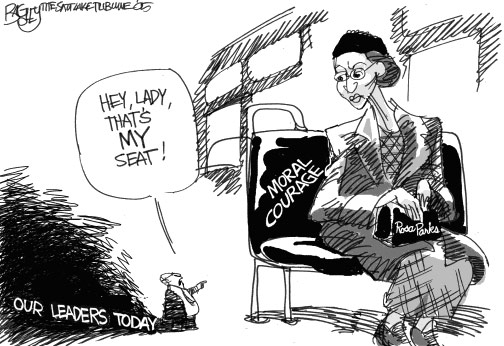Objectives
At the end of the lesson, students will be able to:
- define editorial cartoon
- use strategies to interpret the meaning editorial cartoons
- create their own editorial cartoons
Essential Questions
- Why do artists create editorial cartoons?
- How are editorial cartoons different from other kinds of art and media?
Enduring Understandings
- Artists create editorial cartoons to express their opinions about events in the news.
- Editorial cartoons use pictures and text to make a point or raise questions about a news event.
Vocabulary
editorial [e-də-tȯr-ē-əl] (noun) opinionated content—an essay or a cartoon—that seeks to persuade and reflects the point of view of the author, the media organization’s editors, or its publishers
news report [nooz ruh-port] (noun) text that that informs readers about current events by using facts and interviews
Suggested Procedure
Share with students that an editorial cartoon uses pictures and text to make a statement. Editorial cartoons express opinions about a wide range of topics in the news, such as politics or culture. Cartoonists often use images of well-known people, places and things to send a message. Editorial cartoons can be challenging because you often need background knowledge to understand them.
Share this two-step technique with students: “When you are trying to interpret any editorial cartoon, first look at the picture; then, look at the BIGGER picture. Then ask yourself, ‘What point is the cartoonist trying to make?’
1. First, look at the images and text in the cartoon and describe what you see. What, if anything, looks familiar? What words, if any, are included with any pictures? What do they add to the cartoon?
2. Next, search for the BIGGER picture—the meaning of the cartoon. What is the main point the cartoonist is trying to convey? Is anything exaggerated in the cartoon? If so, why might that be?
3. Ask students to think about what has happened in the past and what is happening in the present as it relates to the cartoon. What connections or comparisons is the artist of the cartoon trying to show you?
Now use the cartoon below to demonstrate how these steps work. Make copies of it and distribute them, or project the cartoon on a screen.

Artist: Pat Bagley, Salt Lake Tribune. Reprinted with Permission. Teachers may purchase individual cartoons for other lesson plans at PoliticalCartoons.com
Ask the class to discuss the following questions:
- What’s going on? Describe the cartoon: what images do you see?
- What does the text say? What does it add to the image?
- What looks familiar in the cartoon?
- Now look at the BIGGER picture:
- What past and/or present event is shown here?
- In what year was this cartoon published?
- What is the artist trying to say?
Extension Activity
Ask students to create their own editorial cartoons about civil rights, using an event from the past to make a connection to today. Have students discuss their drawings with the class. Then display their cartoons in a public space in the school.
Alignment to Common Core State Standards/ College and Career Readiness Anchor Standards CCSS R.2, R.4, R.6, R.7, R.10, SL.1, SL.2, SL.5.
